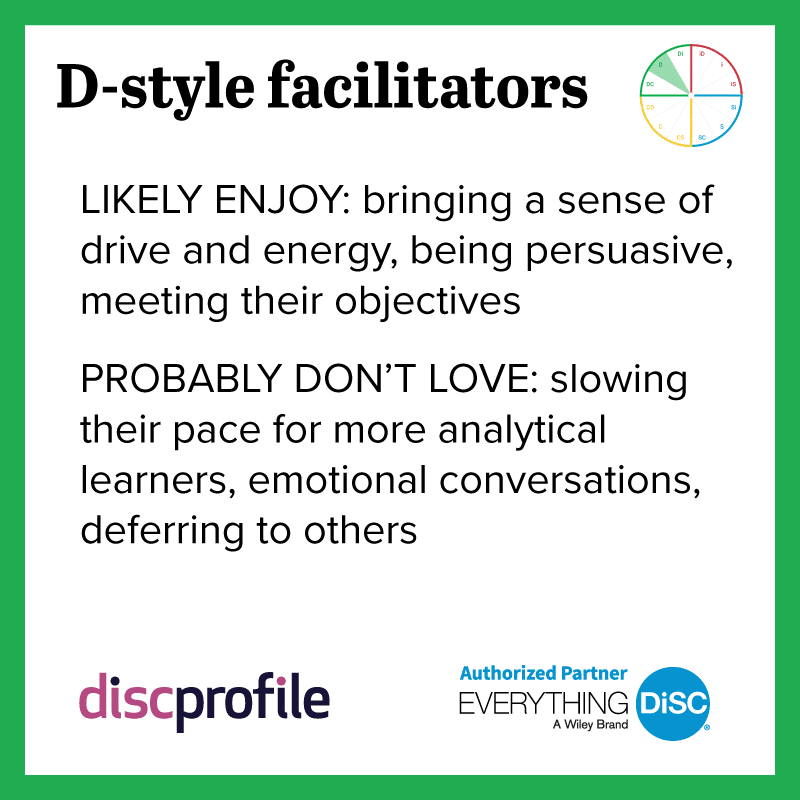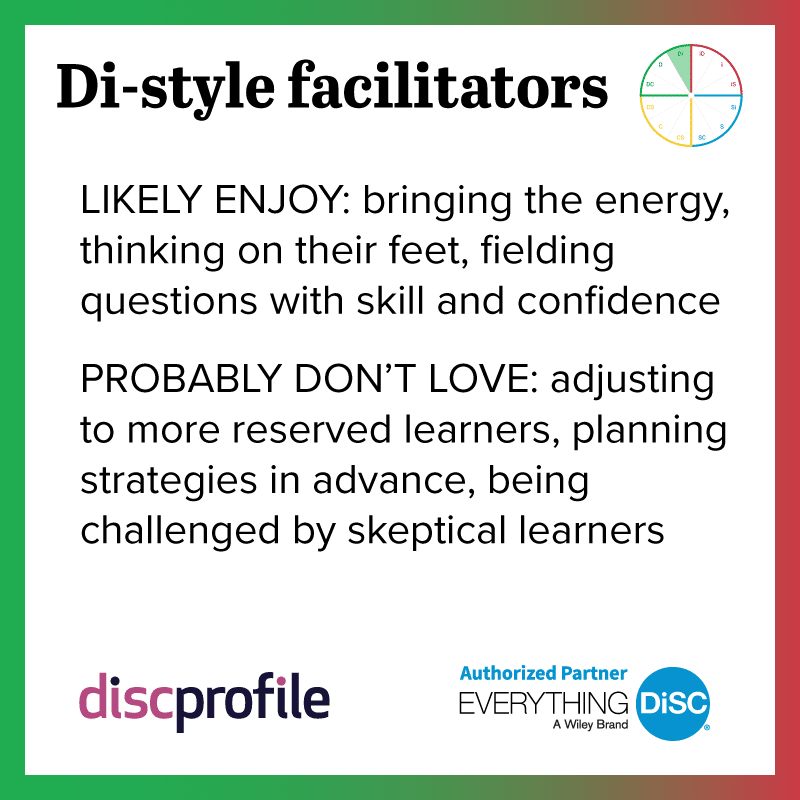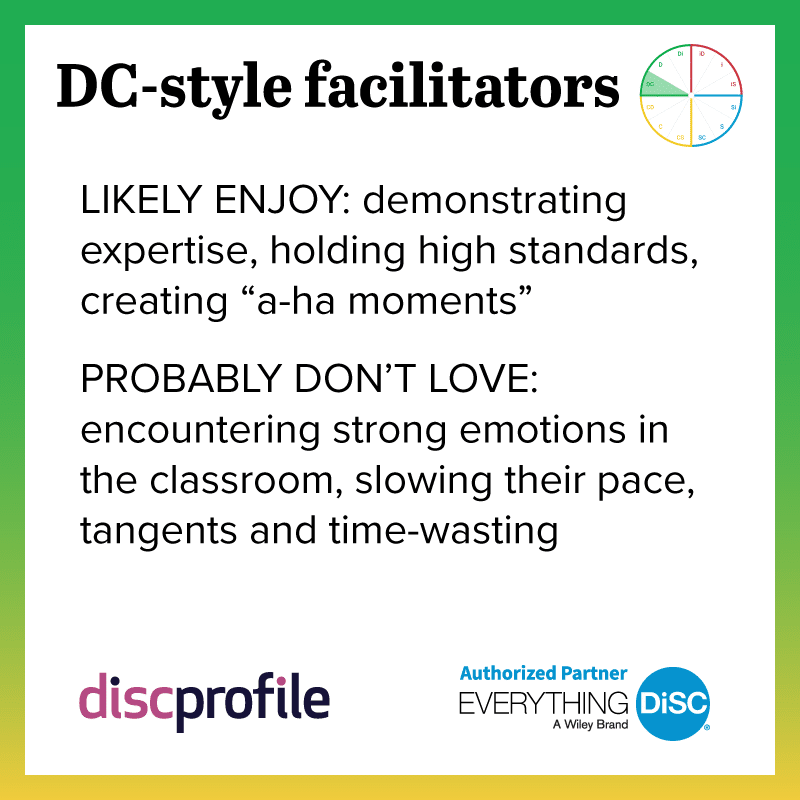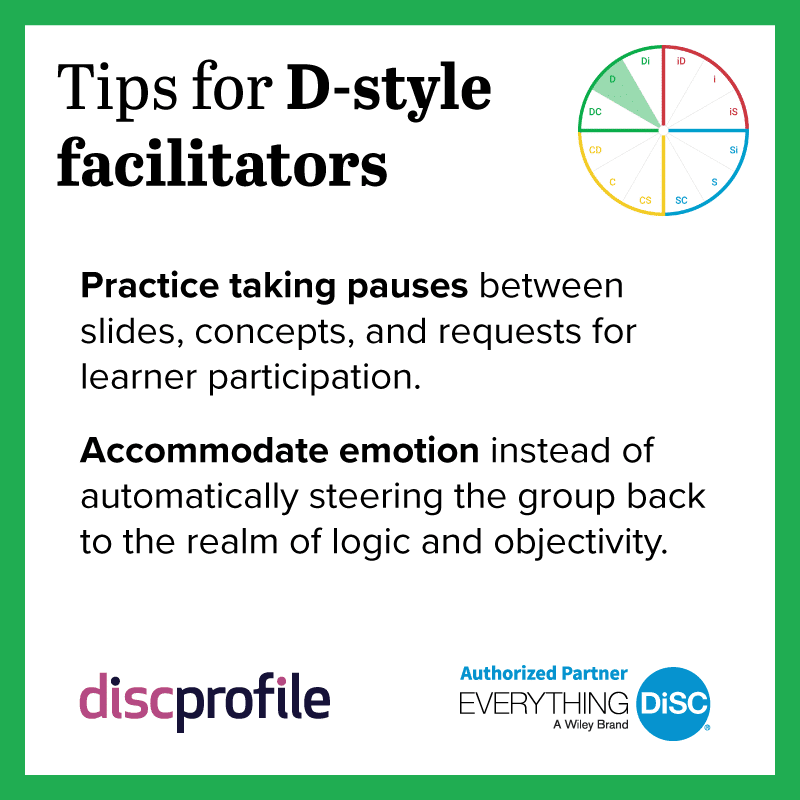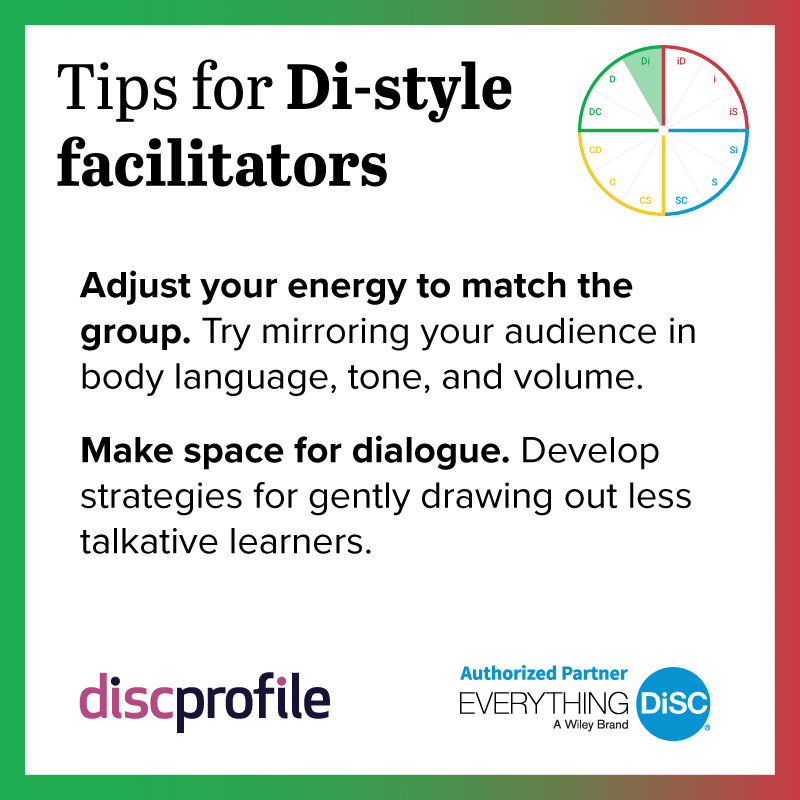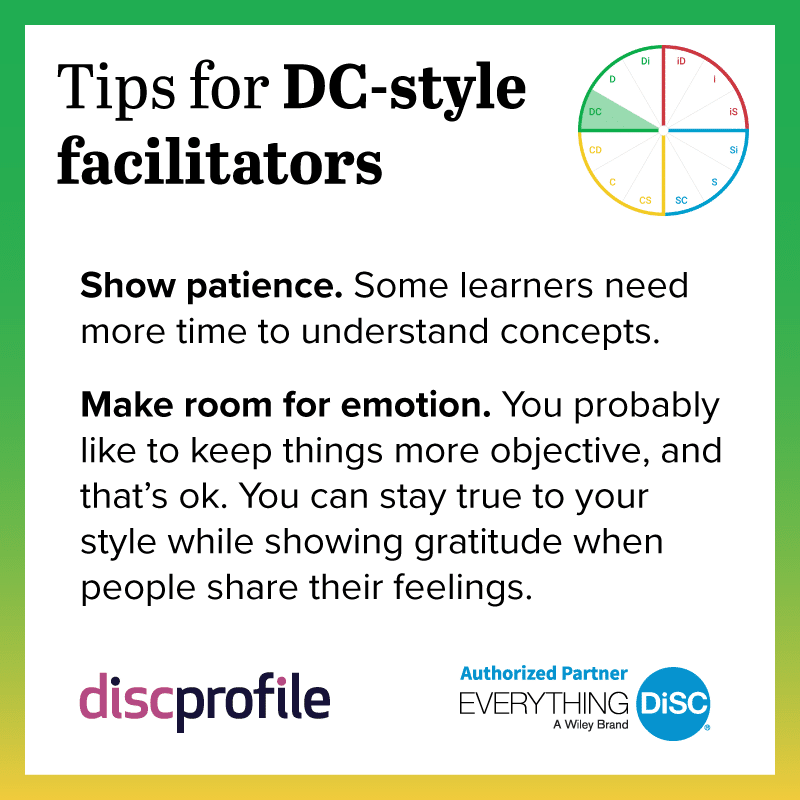Each DiSC® style has strengths and challenges when it comes to facilitation. Do you know yours? We all have blind spots about our own tendencies—they come so naturally to us that we are unable to see them from an outside perspective.
When facilitating, your DiSC style can show up in your pace, energy, and approach to group activities. If you’re a facilitator with a DiSC D-type personality, you likely excel at clear, compelling delivery. You are straightforward and persuasive, holding yourself and others to high standards. Learners can count on you to meet or exceed the goals set for the training.
Getting prepared
Facilitators of every DiSC style should review learners’ profiles and group reports in advance. If you deliver the same training in the same way to a roomful of S-style folks and a roomful of D-style folks, you’ll likely have different results. Doing your homework on the group culture ensures you’ll have the best chance of success.
It may be hard to slow down and take the time for this type of preparation, but doing so allows you to hit the ground running. Learners notice when a facilitator is unprepared. Tailoring your strategies to particular groups demonstrates your competency and makes you look good.
For example:
- Groups with many i-style learners might display more emotion than you would, or share more personal details. Be ready to show gratitude.
- S-style groups might be overwhelmed by your naturally fast pace. Be ready to show patience.
- C-style groups may want details, though you’d rather stay big-picture. Be ready to show understanding.
- Groups with a lot of fellow D-style folks can try to move too quickly, missing important details, or become competitive. Be ready to show discipline.
We offer facilitation tips specific to D, Di, and DC styles below. (See also: tips for S-style facilitators, i-style facilitators, and C-style facilitators.)
Your D style as a facilitator
As a D-style facilitator, you probably enjoy:
- having a clear objective (and meeting it)
- bringing a sense of drive and energy to trainings
- being in control
You may not love:
- when learners want to slow down and analyze things
- when conversations get emotional
- when you need to defer to others
Tips for D-style facilitators
- Take a pause. Practice taking pauses between slides, concepts, and requests for learner participation. These pauses may feel long to you but can help learners who appreciate some time to process or who are hesitant to speak up. You’ll be helping them get more out of your training.
- Accommodate emotion. When a discussion gets emotional, your instinct may be to steer the group back to the realm of logic and objectivity. But remember that an emotional learner may instead prefer to be reassured that it’s OK to express themselves. Practice responding to emotional displays with acknowledgment and gratitude. Emotional learners often understand and retain concepts better when their feelings have been involved.
Your Di style as a facilitator
As a Di-style facilitator, you probably enjoy:
- bringing the energy
- thinking on your feet, taking surprises in stride
- fielding questions and guiding conversation with skill and confidence
You may not love:
- adjusting to a more reserved or cautious group of learners
- planning your strategies in advance
- being challenged by skeptical learners for more details or clarity
Tips for Di-style facilitators
- Adjust your energy to match the group. At times, quieter groups might be overwhelmed by your natural energy. If you sense this happening, try mirroring your audience in body language, tone, and volume. This doesn’t have to be a big change, just a tweak in how you’re presenting yourself. Then notice: does this group of learners engage more when you present a more measured approach?
- Make space for dialogue. Develop a stockpile of strategies for gently drawing out less talkative learners. For example, try small groups, giving them a few moments to compose their response, grouping quiet learners together so more talkative learners don’t dominate small group discussions, offering nonverbal ways to contribute their ideas, going around the room so everyone gets a chance to speak, etc. Sometimes all a learner needs is a little “dead air” so they don’t feel like they’re interrupting if they speak up.
Your DC style as a facilitator
As a DC-style facilitator, you probably enjoy:
- demonstrating your expertise
- holding yourself and your learners to high standards
- creating “aha moments” for learners
You may not love:
- encountering someone emotional in the classroom
- slowing your pace for learners who aren’t understanding
- managing tangents and time wasters
Tips for DC-style facilitators
- Show patience. Some learners will need a little more time to understand concepts or apply DiSC principles in the correct manner. Their questions and missteps are opportunities to foster deeper understanding. Learners may be more likely to embrace your message when they’ve absorbed it at their own pace.
- Make room for emotion. People have all different learning styles, and some people learn best through emotional experiences. You probably like to keep things more objective, and that’s OK. While staying true to your style, you can still show gratitude when people share strong feelings. Making space for emotion allows learners who desire a more personal lens to understand and retain the material.
10-minute tune-up: your DiSC type and facilitation
During your next coffee or tea break, take 10 minutes to explore how your DiSC style and facilitation style influence each other.
- Review your Everything DiSC Workplace® profile. If you’re using the Catalyst platform, focus on the Workplace > What drives you module. In the traditional Workplace profile, take a look at “Motivators & Stressors” on page 6 and “Taking Action” on page 16.
- Pull up your Everything DiSC® Management profile. See Management > Your management style on Catalyst or “Your Management Preferences” on page 6 of the traditional Management profile.
- What stands out to you when you think about your facilitation style? Make notes. Jot down one new idea to try out during your next training session.
You are more likely to meet your training goals when you understand your strengths and challenges as a facilitator. A review of your Everything DiSC® profiles is also a good reminder that what drives you is not always what drives your learners. You must discover how to meet your training objectives and stay true to your personality while stretching toward the various needs of your learners. You won’t be wasting time by thinking through your strategy for this. Sure, it’s a challenge. That’s probably right up your alley.


